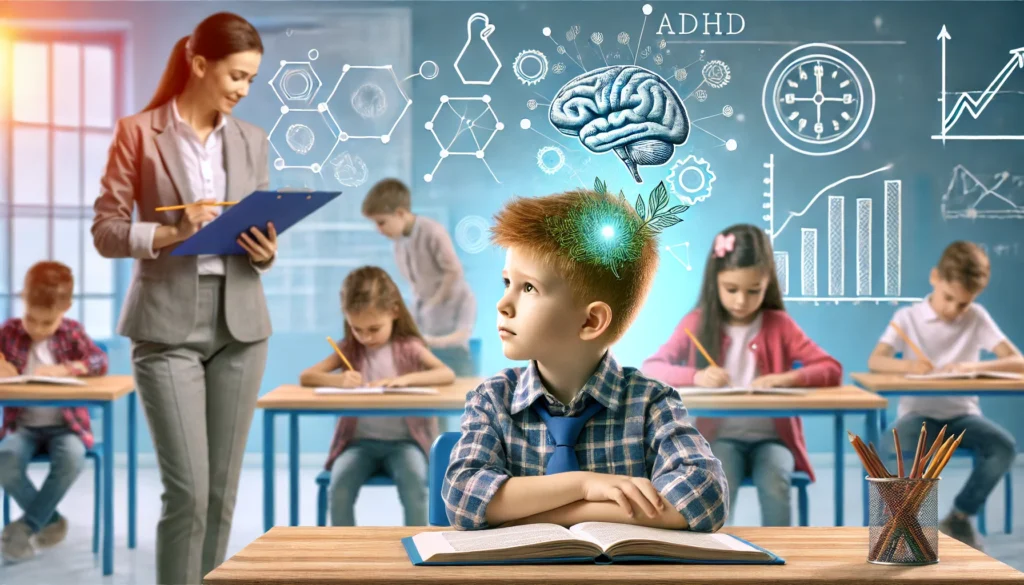Attention Deficit Hyperactivity Disorder (ADHD) is a neurological condition that affects both children and adults, characterized by symptoms such as inattention, hyperactivity, and impulsivity. Understanding the age-related factors and symptoms of ADHD is crucial for timely diagnosis and effective management. This article delves into the intricacies of ADHD, exploring at what age it typically peaks, the age of symptom onset, and how these factors influence the diagnosis and treatment process.
You may also like: Enhancing Concentration: Strategies for ADHD
Understanding ADHD and Its Historical Context
ADHD is not a modern-day phenomenon, but our understanding of it has certainly evolved over time. The earliest medical literature on ADHD symptoms dates back to the late 18th century, and it wasn’t until the 20th century that it was officially recognized as a disorder. Initially, ADHD was thought to affect only children, but current research shows that it can persist into adulthood, affecting various aspects of life, including academic performance, work efficiency, and relationships.
Historical Perspectives on ADHD
The conceptualization of ADHD has changed dramatically over the centuries. In the late 1700s, figures like Sir Alexander Crichton described what we now recognize as ADHD behaviors, though understanding of the condition was rudimentary. It wasn’t until the 1900s that ADHD began to be identified as a distinct disorder, with terms like “minimal brain dysfunction” used to describe its symptoms.
Evolution of Diagnostic Criteria
The criteria for diagnosing ADHD have evolved alongside advances in psychiatric research. Initial descriptions focused heavily on hyperactivity, but subsequent revisions have acknowledged the importance of inattention and impulsivity. The American Psychiatric Association’s Diagnostic and Statistical Manual of Mental Disorders (DSM) has been pivotal in shaping current diagnostic practices, with each edition refining our understanding of ADHD.
ADHD in Modern Society
Today, ADHD is recognized as a complex disorder with genetic, neurological, and environmental components. The stigma surrounding ADHD has decreased over time, though challenges remain in ensuring accurate diagnosis and equitable access to treatment. Public awareness campaigns and advocacy efforts have played a crucial role in enhancing understanding and acceptance of ADHD in society.
Age of Onset: When Do ADHD Symptoms First Appear?
The age at which ADHD symptoms first appear can vary significantly from person to person. Typically, symptoms are noticeable before the age of 12, with some children showing signs as early as preschool. Early diagnosis is critical, as it allows for interventions that can help manage symptoms more effectively.
Early Childhood Indicators
In early childhood, parents and caregivers might observe behaviors that hint at ADHD, such as difficulty following instructions, excessive fidgeting, or an inability to play quietly. These early signs can often be mistaken for typical energetic childhood behavior, making early diagnosis challenging but crucial for intervention.
Preschool and Kindergarten Observations
As children enter more structured environments like preschool and kindergarten, ADHD symptoms can become more evident. Teachers might notice a child’s inability to stay seated during activities, frequent interruptions, or trouble sharing and taking turns. These observations can prompt referrals for further evaluation.
The Importance of Early Intervention
Early intervention can significantly impact the long-term management of ADHD. Identifying symptoms at a young age allows for the implementation of behavioral strategies and, when appropriate, medication to help children adapt to learning environments and social situations. Early support can lay the foundation for better academic and social outcomes.

ADHD Peak Age: When Does ADHD Reach Its Maximum Intensity?
Research indicates that ADHD symptoms often peak during childhood, particularly between the ages of 7 and 9. This is the period when hyperactivity and impulsivity are most pronounced. However, as children grow older, these symptoms can evolve. While hyperactivity may decrease, challenges with attention and executive function might persist or even become more apparent during adolescence and adulthood.
Childhood Peak and Its Implications
During the peak years of ADHD symptoms, children may exhibit behaviors that significantly impact their academic and social lives. Hyperactivity can lead to disruptions in the classroom, while impulsivity might affect peer relationships. Understanding this peak phase is vital for implementing appropriate interventions that address these specific challenges.
Shifts During Adolescence
As children with ADHD transition into adolescence, the nature of their symptoms often shifts. Hyperactivity may diminish, but issues with attention and executive function can become more problematic. Adolescents may struggle with organizing tasks, meeting deadlines, and managing time, necessitating tailored support strategies.
Long-Term Symptom Trajectory
For many individuals, ADHD symptoms persist into adulthood, albeit in different forms. Adults often report difficulties with sustaining attention, managing responsibilities, and maintaining consistent performance at work. Recognizing these long-term trajectories is essential for developing lifelong management plans that address evolving needs.
Symptom Onset and Development Over Time
Childhood
In childhood, ADHD symptoms can manifest in various ways, including difficulty staying focused, hyperactivity, and impulsive behavior. These behaviors often lead to challenges in school settings, where structured tasks and sustained attention are required. It is during this stage that interventions, such as behavioral therapy and medication, are most commonly introduced.
Classroom Challenges
Children with ADHD may struggle to adapt to the structured demands of a classroom environment. Difficulty following instructions, staying seated, or completing assignments can lead to academic underperformance. Teachers play a pivotal role in identifying these challenges and supporting students through individualized education plans and accommodations.
Social Interactions and Play
ADHD symptoms can also impact a child’s ability to engage in social interactions and play. Impulsivity may lead to conflicts with peers, while inattention can cause difficulty in following group activities. Encouraging positive social skills and providing structured play opportunities can help mitigate these challenges.
Role of Parents and Caregivers
Parents and caregivers are essential partners in managing childhood ADHD. Their involvement in implementing behavioral strategies, monitoring progress, and collaborating with educators is crucial. Support groups and resources for parents can provide valuable guidance and foster a supportive community.
Adolescence
During adolescence, ADHD symptoms can shift. Hyperactivity often decreases, but inattention and impulsivity may remain. Adolescents with ADHD might struggle with academic demands, social interactions, and the transition to more independent living. It’s essential to adapt management strategies to address these evolving challenges.
Academic Pressures
Adolescents face increased academic pressures, and ADHD can exacerbate these challenges. Time management, organization, and study skills become critical areas of focus. Support from school counselors and tailored academic accommodations can aid students in achieving their educational goals.
Navigating Social Relationships
The teenage years are marked by complex social dynamics, which can be particularly challenging for adolescents with ADHD. Impulsivity and inattentiveness can affect friendships and romantic relationships. Encouraging open communication and fostering self-awareness can help adolescents navigate these social landscapes.
Preparing for Independence
As adolescents approach adulthood, preparing for increased independence becomes essential. Life skills training, including financial management and planning, can equip them for future responsibilities. Encouraging self-advocacy and self-management strategies can empower adolescents to take charge of their ADHD.
Adulthood
While some individuals experience a reduction in ADHD symptoms with age, others continue to face significant challenges into adulthood. Adult ADHD symptoms often include difficulties with time management, organization, and maintaining focus on tasks. Adults might also experience emotional dysregulation, which can impact work performance and personal relationships.
Workplace Adaptations
Adults with ADHD may encounter challenges in the workplace, such as meeting deadlines, organizing tasks, and maintaining productivity. Employers can support these individuals by offering flexible work arrangements, clear communication, and reasonable accommodations to enhance job performance.
Managing Personal Relationships
ADHD can impact personal relationships, with symptoms sometimes leading to misunderstandings or conflicts. Developing effective communication skills and emotional regulation techniques can improve relationship dynamics. Couples therapy or support groups may also be beneficial in fostering healthy relationships.
Pursuing Personal Growth
Adults with ADHD can pursue personal growth through various means, such as lifelong learning, hobbies, and volunteer activities. Finding areas of interest and passion can help maintain focus and motivation. Seeking support from ADHD coaches or therapists can also facilitate personal development and goal achievement.

Current Trends in ADHD Diagnosis and Management
The approach to diagnosing and managing ADHD has shifted significantly over the years, with an increased focus on personalized treatment plans. These plans often combine medication, behavioral therapy, and lifestyle modifications to address the unique needs of each individual.
Advances in Diagnostic Tools
Modern diagnostic tools for ADHD have become more sophisticated, incorporating a combination of clinical assessments, behavioral observations, and neuropsychological testing. These tools aim to provide a comprehensive evaluation, ensuring accurate diagnosis and tailored treatment recommendations.
The Role of Medication
Stimulant medications, such as methylphenidate and amphetamines, are commonly prescribed to manage ADHD symptoms. These medications work by increasing the levels of certain neurotransmitters in the brain, helping to improve focus and reduce impulsivity and hyperactivity.
Mechanism of Action
Stimulant medications function by enhancing dopamine and norepinephrine activity in the brain, which are neurotransmitters linked to attention and impulse control. Understanding these mechanisms helps healthcare providers tailor medication choices to individual patient needs, optimizing treatment outcomes.
Balancing Benefits and Side Effects
While stimulant medications are effective for many individuals, they can also have side effects, such as appetite suppression, sleep disturbances, and increased anxiety. Ongoing communication with healthcare providers is crucial to balancing therapeutic benefits with potential side effects, ensuring optimal treatment adherence.
Non-Stimulant Alternatives
For some patients, non-stimulant medications, such as atomoxetine or guanfacine, may be preferred options. These medications offer alternative mechanisms for managing ADHD symptoms and can be particularly beneficial for individuals who do not respond well to stimulants or experience significant side effects.
Behavioral Therapy and Lifestyle Changes
Behavioral therapy is a critical component of ADHD management, providing individuals with strategies to cope with their symptoms. Additionally, lifestyle changes, such as regular physical activity, a healthy diet, and mindfulness practices, can support overall well-being and symptom management.
Cognitive Behavioral Therapy (CBT)
Cognitive Behavioral Therapy (CBT) is a widely used therapeutic approach that helps individuals with ADHD develop coping strategies, improve organizational skills, and enhance emotional regulation. CBT can be tailored to address specific challenges faced by children, adolescents, and adults with ADHD.
Importance of Physical Activity
Physical activity is known to positively affect ADHD symptoms, improving focus, mood, and executive function. Incorporating regular exercise into daily routines can be a powerful adjunct to medication and therapy, fostering physical and mental well-being.
Nutrition and ADHD
Dietary choices can impact ADHD symptom management, with some evidence suggesting that certain nutrients, such as omega-3 fatty acids, may support cognitive function. While dietary interventions alone are not a substitute for medical treatment, they can complement other strategies to enhance overall health.

Future Implications and Biohacking Approaches
The future of ADHD diagnosis and treatment is promising, with ongoing research exploring new therapeutic options and biohacking techniques. Nootropic supplements, designed to enhance cognitive function, are gaining popularity among those looking to manage ADHD symptoms naturally. While the efficacy of these supplements varies, they represent an exciting frontier in ADHD management.
Emerging Therapeutic Technologies
Advancements in technology, such as neurofeedback and digital therapeutics, hold potential for innovative ADHD treatments. These approaches aim to harness the brain’s neuroplasticity to improve attention and reduce impulsivity, offering non-invasive alternatives to traditional therapies.
Nootropics and Cognitive Enhancement
Nootropics, often referred to as “smart drugs,” are substances believed to enhance cognitive performance. While research on their efficacy in ADHD management is ongoing, some individuals report benefits in focus and memory. It’s important to approach nootropics with caution and consult healthcare professionals before use.
Ethical Considerations in Biohacking
The rise of biohacking and self-experimentation in managing ADHD raises ethical questions about safety, efficacy, and accessibility. Ensuring that individuals have access to reliable information and professional guidance is crucial to navigating these emerging trends responsibly.
The Importance of Continued Research
Continued research is crucial for understanding the complexities of ADHD and improving treatment options. Advances in neuroscience and genetics may lead to more targeted therapies, offering hope for individuals affected by ADHD.
Genetic Insights and Personalized Medicine
Genetic research is uncovering potential biomarkers for ADHD, paving the way for personalized medicine approaches. By understanding an individual’s genetic profile, healthcare providers may tailor treatments to enhance efficacy and minimize side effects, ushering in a new era of precision healthcare.
The Role of Neuroimaging
Neuroimaging technologies are providing insights into the structural and functional differences in the brains of individuals with ADHD. These advancements may lead to more accurate diagnostic criteria and novel therapeutic targets, improving outcomes for patients.
Interdisciplinary Collaboration
Collaboration across disciplines, including psychiatry, neurology, and education, is essential for advancing ADHD research and treatment. Interdisciplinary efforts can drive innovation, foster holistic approaches, and ensure comprehensive support for individuals with ADHD.
Conclusion
Understanding the age factors and symptoms of ADHD is essential for timely diagnosis and effective management. By exploring the historical context, current trends, and future implications of ADHD, we can better equip ourselves to support individuals with this condition. Whether you’re a health and wellness coach, a science journalist, or a biohacker, staying informed about the latest research and management strategies is key to providing accurate and practical advice.
ADHD is a multifaceted condition that requires a comprehensive approach to management, encompassing medication, therapy, and lifestyle modifications. As our understanding of ADHD continues to evolve, so too will the ways we diagnose and support those affected by it, offering hope for a brighter future.
Further Reading:
Attention-Deficit/Hyperactivity Disorder (ADHD)
What is ADHD? A guide to ADHD diagnosis, co-morbidity & treatment
Important Note: The information contained in this article is for general informational purposes only, and should not be construed as health or medical advice, nor is it intended to diagnose, prevent, treat, or cure any disease or health condition. Before embarking on any diet, fitness regimen, or program of nutritional supplementation, it is advisable to consult your healthcare professional in order to determine its safety and probable efficacy in terms of your individual state of health.
Regarding Nutritional Supplements Or Other Non-Prescription Health Products: If any nutritional supplements or other non-prescription health products are mentioned in the foregoing article, any claims or statements made about them have not been evaluated by the U.S. Food and Drug Administration, and such nutritional supplements or other health products are not intended to diagnose, treat, cure, or prevent any disease.


